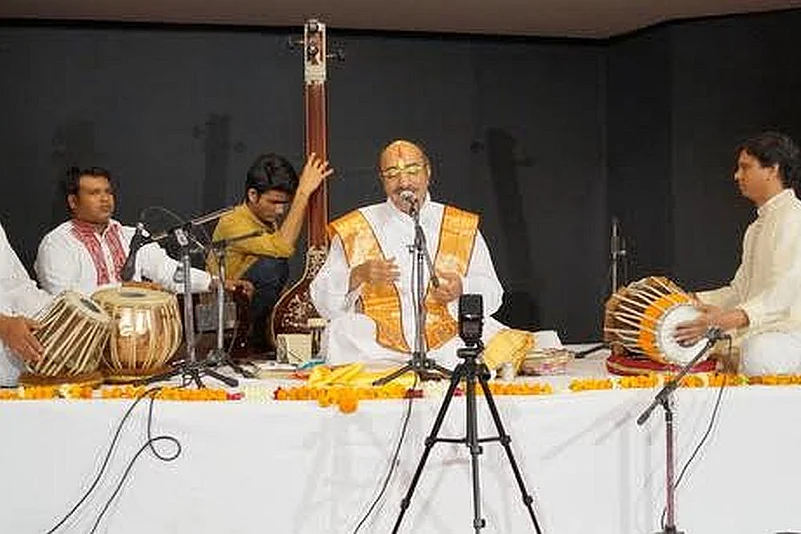Gokulotsavji Maharaj wouldn’t let out the exact reason why he sports that strange yellow paint around his eyes while rendering classical vocal, but the senior artiste would turn garrulous when the topic is more general: Hindustani music.
Yet, not once did the septuagenarian sound wistful—in contrast to the mood that prevailed over a group of theatre persons who gathered in the same city of Delhi a couple of days subsequently.

Maharaj, at the outset of an interactive session by a Jaipur-based organisation, sought to nullify the general notion that veer (valour) constituted the dominant rasa in the ancient Dhrupad stream of north Indian music. “It has all the human emotions, including bhakti (devotion),” the Padma Bhushan awardee said. “The alaap (the detailed sketch of a raga) and the intermittent nom-tom (sounds) should suitably evoke the feeling of the entailing lyrics in the (short) composition.”
The Indore-based artiste, who has created more than an incredible 5,000 compositions in khayal and dhrupad in Sanskrit, Persian, Urdu and Braj, then substantiated his point by presenting a piece in Yaman. “It is one by Miyan Tansen before he came to Mathura and Vrindavan (in present-day Uttar Pradesh),” he informed about the right-raga item that reiterated the 16th-century composer’s complete submission to god.

At the March 25 ‘Gunijan Sabha’ hosted by Ustad Imamuddin Khan Dagar Indian Music Art & Culture Society and the Dagar Archives, the gathering at India Habitat Centre was taken into the fascinating labyrinths of the Dhrupad and Khayal subgenres alongside occasional forays into Haveli Sangeet. “From ‘Megh’ came ‘Sarang’,” the maestro noticed, referring to a connection between the two famed raga families and their kinetics.
Maharaj, who is primarily groomed under Pandit Moreshwarrao Golvelkar while also growing up listening to recordings of masters such as Aman Ali Khan, Bhindi Bazarwale and Abdul Wahid Khan, did particularly recall the icon who inspires him the most: Ustad Amir Khan (1912-74). Moderated by scholar-vocalist Neeta Mathur, the session saw Maharaj accompanied on the tabla by Avijit Aich, Manmohan Nayak (pakhawaj) and Zakir Dholpuri (harmonium). The vocalist did demonstrate his mastery over the pakhavaj by playing the percussion instrument briefly.

Shabana Dagar, who is director of the society that organises the monthly programme in the national capital, said the 22nd Gunijan Sabha in end-April will feature Kathak veteran Nandini Singh and her contributions to the classical dance.
Three days after Maharaj’s show, four iconic theatre groups from Delhi came together to embark on an ambitious project that aims to bring alive the memories and contribution of a “golden period” of theatre in the national capital. Natrang Pratishtan, a city-based archive and resource centre for Indian theatre, will strive to “give the youngsters of today a glimpse into that period of Delhi theatre,” according to scholar-writer Ashok Vajpeyi, executive trustee of the Raza Foundation that is spearheading the endeavour.
At a two-day ‘Rang Smaran’ hosted by the Sahitya Akademi on March 28-29 saw members of Abhiyan, Yatrik, Dishantar and Delhi Art Theatre take a trip down memory lane, while also lamenting an absence of good original writing and translations that could be turned into plays. Veteran theatre personality Rajinder Nath, who set up the Abhiyan theatre group in 1967 to produce original scripts never done in Hindi, said there is “a drought of plays today”.

Anuradha Kapoor of Dishantar, another premier drama group founded in the 1960s by Om Shivpuri, recollected the struggles of theatre people then to find spaces for rehearsals and how certain school principals had lent them their auditoriums for the cause.
Members of the Delhi Art Theatre, launched by the late Shiela Bhatia and well known for introducing the Punjabi opera form to city audiences through productions, also shared experiences. Actors Sunit Tandon, Sushma Seth, Bhaskar Ghosh and Avijit Dutt took turns to relive their experiences with the 1964-founded repertory Yatrik that stages bilingual performances of theatre, music and dance in Delhi.
As for the project, the idea is to record an oral history for posterity, said Kirti Jain of Natrang Pratishtan. “We will also undertake a documentation of the old theatre groups of Delhi.” Since 1947, it has been “really an exciting period with many emerging theatre groups but unfortunately there is no physical record of it. Our aim is to capture those moments and memories for the younger generation.” Kirti is the daughter of the late Nemichand Jain, a poet and theatre person who founded Natrang, the country’s oldest-surviving theatre journal.
Interestingly, after arriving in the capital from Lahore, Sheila Bhatia, a mathematics schoolteacher, started Delhi Art Theatre here in 1951 and subsequently produced plays in Hindi, Urdu, Punjabi and Hindustani. Among her plays, Heer Ranjha, Ghalib Kaun Tha and Dard Ayega Date Paon drew celebrated names such as Kaifi Azmi and Begum Akthar. Jawaharlal Nehru, then the prime minister, was among those who came to watch the shows.
“Shielaji was brought up in a family where there was a tradition of singing folk songs,” recalledd Amba Sanyal, whose mother Swarnalata Sanyal was among the founding members of Delhi Art Theatre. “She introduced that into theatre here. She gave birth to the idea of opera theatre of India.”
A short video clip featuring Shiela narrating the origin of the theatre group and recounting various anecdotes relating to it was screened. Madan Bala Sidhu, Vinod Nagpal and Malavika Khanna were among others who shared tidbits of their association with the group.
Also on show at the Sahitya Akademi was a small exhibition of the photos, brochures and playlists giving a glimpse of the journey these groups have taken.
(The video is from an earlier show of the vocalist.)














